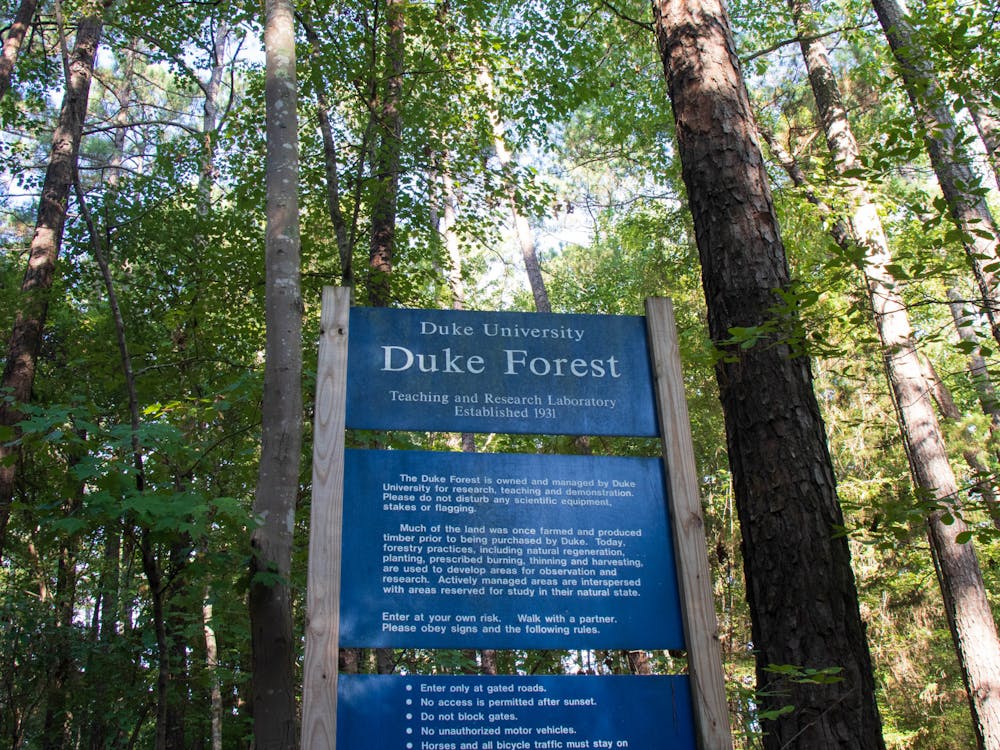The Duke Forest is once again closed for students but it’s open season for deer hunters.
In its 15th year, the deer herd reduction program began this year on Sep. 26 and will conclude on Dec. 16. By permitting entry only to certified hunters, the program manages the forest’s health by controlling the population of white-tailed deer, specifically allowing hunters to target does.
The Durham, Korstian and Blackwood Divisions of the forest are closed to the public Monday through Friday while the program is operating in order to protect the safety of visitors and avoid hunting accidents.
The program aims to promote “ecological benefits” and “our goals have nothing to do with hunting for sport,” according to Maggie Heraty, Program Coordinator for the Duke Forest.
“Recreation is a longstanding, ancillary benefit to the Forest’s existence, but our important teaching and research mission and the ecological health of the Duke Forest is our primary focus,” Heraty wrote.
The reduction program has a number of benefits, including protecting plants and habitats from overabundant deer feeding, ensuring that the deer population remains healthy and free from disease, reducing deer-vehicle collisions and human fatalities, and facilitating the continuation of the Duke Forest’s teaching and research. Heraty wrote that the longevity of the program has produced “noticeable impacts,” including an improvement in regeneration in tree stands.
“Deer populations above the ecological carrying capacity are dangerous for humans, other plants and animals in the forest, and for the deer themselves,” said John Poulsen, associate professor of tropical ecology at the Nicholas School of the Environment.
“If you have lots of deer, that could result in having higher incidences of disease among the deer so that they're either unhealthy or eventually they die off,” Poulsen said. He also noted that too many deer can change the composition of the forest, as overconsumption of certain plants may lead to the local eradication of some species.
Hunting is “a common tool that’s used, particularly when the top predators have been removed from the system,” Poulsen said. Because the white-tailed deer’s top local predators, the eastern cougar and the red wolf, have become either extinct or endangered due to human intervention, deer populations are now at high levels.
The density of white-tailed deer in Durham County is estimated at 41-50 per square mile, according to the N.C. Wildlife Resources Commission. The generally accepted carrying capacity for counties in North Carolina is 8-26 per square mile.
“I don’t think there’s any good environmental reason for there not to be deer management,” Poulsen said. “There's a good reason to do it, and that's to keep the forest healthy so that it also stays a healthy habitat for the deer.”
The deer herd reduction program is again partnering with the North Carolina Bowhunters Association, a group of certified bowhunters, and the Chapel Hill Wildlife Management Group, which is mainly composed of current and former Chapel Hill police officers, according to Heraty.
The program partnered with these two groups for last year’s hunt, and all hunters were trained again at the beginning of the 2022 season.
The program is also followed up each year by a spotlight survey, in which forest employees “drive standardized routes over a series of nights, use a spotlight to count deer, and estimate the deer population density,” Heraty wrote.
The data collected is used to analyze deer population trends in the forest following the reduction program. The next spotlight survey will take place in February.
Get The Chronicle straight to your inbox
Signup for our weekly newsletter. Cancel at any time.

Holly Keegan is a Trinity junior and a senior editor of The Chronicle's 120th volume.

